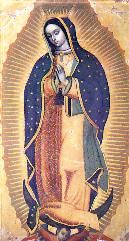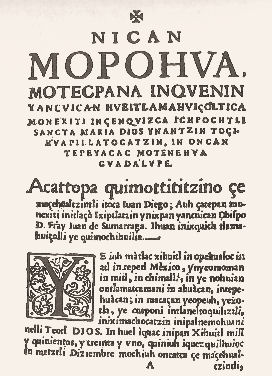File last modified:
Go to First Chapter

When Hernán Cortés (1485-1557) arrived in Mexico, he was both destined and determined to change its history forever. The Aztec polity crumbled before the forces of its Mexican enemies, united and energized by Cortés' far fewer troops, and a Spanish polity arose to fill the vacuum left by the Aztec collapse. Spanish Catholicism immediately became the official religion, and the "old gods" were quickly reduced to historical curiosities. Perhaps surprisingly quickly.
A Mexican convert named Cuauh-tlahtoa ("Eagle Speaks") was baptized in 1525, a scant six years after the first arrival of Cortés on the Veracruz coast. Probably born in 1474, he would have been 45 when Cortés arrived in Mexico, and 51 when he was baptized. He was given the baptismal name Juan Diego and is today known as St. Juan Diego Cuauhtlatoatzin (Beloved Eagle-Speaks). Six years later, on December 9, 1531, according to tradition, Juan Diego was passing over the hill of Tepeyac ("Nose of the Hill") when he witnessed an apparition of the Virgin, who asked him to have a shrine built for her on that site.
She appeared to him as a young, Nahuatl-speaking Mexican, although the name Guadalupe is associated with a town of that name in Estremadura, Spain, a region where many Spaniards in Mexico had been born.
The hill of Tepeyac is said to have been a sacred place of long standing, the seat of the cult of an obscure goddess known to us only as "Our Beloved Mother" (To-nan-tzin), whose name, after the Spanish Conquest, became confusingly suggestive of the veneration of the Virgin Mary of Catholicism. (The Italian historian Lorenzo Boturini visited the site in 1740 and was able to copy a petroglyph of the earlier Tonantzin still extent at the foot of the hill.)
The account of Juan Diego and his efforts to carry out the apparition's wishes to build a shrine on the hill is known as the "Nican Mopohua" ("Thus It Is Told"), after its opening words, and it has been understood for centuries to be the definitive account of what happened.
The veneration of the Virgin of Guadalupe spread extremely rapidly, and has been major feature of Mexican civilization for the last four and a half centuries (about twice as long as the Aztec régime ruled the land). Skeptics doubt both the apparition and the documentation which purports to authenticate it, but faith in the Guadalupe shrine and its associated symbols is nearly universal in Mexico to this day. For this reason, the Nican Mopohua, as the cornerstone document, may appropriately be called the most influential text ever produced in Nahuatl.
Nobody knows who composed it, although the most commonly proposed author is Antonio Valeriano (1531?-1605), who is widely thought to have put it together about 1560 or so (about thirty years after the events) from stories circulating at that time. (Some sources place Valeriano's birth, at Azcapotzalco, as early as 1520, hence just before the fall of Tenochtitlan, and he is thought to have been descended from the royal house of Tlacopan, part of the Aztec Triple Alliance.)

Valeriano, whose Nahuatl name is unknown, was a respected collaborator with Bernardino de Sahagún, and served as the royal “Judge-Governor” of México-Tenochtitlan for over a quarter of a century, from 1573 to 1599. The picture of him here is from the Aubin Codex. He spoke Nahuatl natively, was educated in Spanish and Latin, and clearly understood the world of early post-Conquest Mexico.
Manuel Robledo Gutiérrez (1978: 5) recounts that at the time of Valeriano's death the original MS was passed to the famous Fernando de Alva Ixtlilxochitl (1568?-1648), historian, governor of Texcoco (and later of Tlalmanalco), and descendant of the royal house of Texcoco.
From him, the MS was willed to “a learned Jesuit,” from whom it made its way over the years to the library of the Real Universidad de México, which suffered a destructive fire in 1792 and a sacking by American forces in 1847, who removed some 28 remaining volumes of Jesuit records. Robledo opines that the original text, not actually seen since the 1700s, if then, may now be in some unknown war archive of the Department of State. (For a discussion of an early manuscript in the New York Public Library that may be this same one, click here. To view pages from it, click here. Thanks to Sergio Asunción for calling this copy to my attention.)
The earliest printed edition now known dates from 1649, about ninety years after the work was composed.

There are countless Nahuatl transcriptions of this text, as well as Spanish and English translations, often anonymous. The text given here was anonymously offered on various internet sites but corresponds also with published pamphlets available in Mexico (including that of Manuel Robledo Gutiérrez, cited above). The spelling is slightly modernized. The present text (line 40) speaks of Bishop Juan de Zumárraga, for example, whose name is spelled Iuan de Sumarraga in the 1649 printing. The 1649 volume uses the letter Ç where modern texts use Z. And so on. And some clear misprints in the 1649 printing are corrected in modern texts.
The present bilingual presentation began as a reading for our erstwhile Classical Nahuatl study group, which is why it contains occasional odd "form challenges" concerned with language usage. It then became a reading in various anthropology classes, and "content challenges" were added here and there to promote attention to the flow of the narrative.
I have corrected some errors in the Nahuatl text, apparently introduced by electronic scanning, referring for that purpose to several different printed versions. I possibly missed a few, and added a few new ones, I fear. Special thanks to Stephen Menn for his eagle-eyed attention and his kindness in getting back to me when he discovered problems.
I have also freely —sometimes substantially— modified the anonymous English translation in places where it seemed untrue to the original text. I have usually let stand sequence-of-tense errors that reflect abrupt tense shifts in the Nahuatl original. Unfortunately, my knowledge of Nahuatl is insufficient for me to appreciate whether the flow of verb forms here is clumsy in Nahuatl or not. Obviously, overly precise translation makes clumsy English, but if one's interest is language, it can help to show the structure of the original text.
I have added chapter divisions to facilitate keeping your place in the text, and I have put the chapters on separate pages to avoid excessive file length. In a few notes I have included marking for long vowels. In those cases, the macrons normally used to indicate long vowels in Nahuatl (ā, ē, ī, and ō) are replaced with umlauts (ä, ë, ï, and ö) to agree with the usage in the on-line Nahuatl lessons and reference grammar.
A more fluent translation by Father Real Bourque, with the same section numbering, is sometimes available on the Internet, but in my experience it does not remain long at any single URL.
A new, more graceful English version seemed desirable, and I am grateful to Mr. Ramón Abajo for inspiring me to undertake a new rendering, oriented to the needs of readers interested in the content rather than the language of this fascinating work and suitable for printing if desired. For that monolingual English version, with the line numbers, click here; for the same text without line numbers click here. Mr.Abajo is a formidable calligrapher, and his hand transcription of the Nahuatl text and a Spanish translation has produced a magnificent volume, luxurious copies of which are now in production in support of the New York Public Library. (Link.) An English version is in preparation.
Vocative Forms. Linguistically you will notice the "vocative" form used frequently in this text. It ends in E and is the only form in Nahuatl which shifts the stress to the final syllable: Nopiltzé = "My child!" In modern Nahuatl this shift in stress is always shown with an accent mark on the final E. (A whole series of these occurs in line 024.)
Apposition. You will also notice extremely frequent use of apposition, beginning with the opening words, "here it is told, set down, …." This was common in very formal narrative, and was apparently considered extremely eloquent in Nahuatl, tedious though it rapidly becomes in English. If the writer of the Nican Mopohua was not Valeriano but rather someone for whom Nahuatl was a second language (such as a Spanish priest), one can imagine that he may have tended to overuse this device hoping to convey an appropriately elevated tone, a bit like the use of mock King James English in modern prayers.
Reverential Verbs. You will also find here, as in other formal texts, frequent use of "reverential" verbs, which needlessly apply an applicative or causative ending and then cancel it with a reflexive prefix, thereby lengthening the word while leaving the direct meaning unchanged. The effect was more syllables and greater formality. (There are examples in line 022.)
A verb you will find repeatedly here is nequi Vt2 = to desire.
In the present text, the Virgin wants a chapel built for her, and both she and Juan Diego make frequent use of nequi in discussing it.
The Diminutive/Reverential Suffix -Tzin. A challenge for the English translator is the suffix -tzin, heavily used in this text. On the one hand, it is a diminutive, used for children and pets. On the other hand it is reverential, used for lords and gods. And sometimes it seems to be thrown in merely to show that the situation, the audience, or the text itself is classy or much loved or both.
It is inaccurate to equate -tzin routinely with the Spanish diminutive, which is more limited in scope, although probably somewhat expanded in Colonial Mexico under the influence of Nahuatl usage. (Mexicans even today are sometimes mocked by other Spanish speakers for their "excessive" use of diminutive forms. For example, I once heard a Mexican guide refer to the tourists she was leading as personitas.) But it is even less reasonable to equate -tzin to any standard English usage.
To my ear, the best default "translation formula" for -tzin is probably "beloved," since that was formerly used in English for everyone from children to monarchs, although it is now quaintly dated in virtually all contexts. Quaint or not, it beats calling the Virgin a "little girl" to her face, as some translators have done! Many of the changes I have made in the anonymous English translation have attempted to "fix" translations of -tzin that struck me as mischievous.
Sources Consulted
(Excluding Nahuatl Dictionaries &c.)
- GALERA LAMADRID, Jesús
- 1991 Nican mopohua: breve análisis literario e histórico. Mexico city: Editorial Jus.
- JOHNSTON, Francis
- 1981 The wonder of Guadalupe. Mexico City: editorial Verdad y Vida.
- LEÓN-PORTILLA, Miguel
- 2000 Tonantzin guadalupe: pensamiento náhuatl y mensaje cristiano en al "Nican Mopohu"". Mexico city: El Colegio nacional, Fondo de Cultura Económica.
- ORTIZ de MONTELLANO, Guillermo
- 1990 Nicān mopohua. Mexico City: Universidad Iberoamericana
- RIUS
- 1981 El mito guadalupano. Mexico City: Editorial Posada.
- RUBLEDO GUTIÉRREZ, Manuel
- 1978 Nican mopohua. Mexico City: Privately published.
- SÁNCHEZ FLORES Ramón
- 1996 La virgen de la patria: leyenda, tradición e historia de la guadaluplana del Tepeyac. Puebla: Comité Directivo Estatal.
- VELÁZQUEZ, Primo Feliciano
- n.d. Nican mopohua: la narración mas antigua de las apariciones guadalupanas escrita en náhuatl y traducida al español. Mexico city: Obra Nacional de la Buena Prensa.
(Having consulted all these authorities, I must concede that remaining mistakes are my own fault.)
Except for paintings, the images illustrating this story are photos taken by me during a visit to Tepeyac in 2005.
Go to first chapter
Return to top.